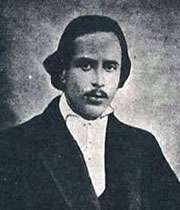Mohammad-Reza Mirzada Eshqi
part 1

Eshqi, Mohammad-Reza Mirzada (b. 12 Jomada II 1312/11 December 1894; killed 12 Tir 1303 SH./3 July 1923, Figure 1), poet and journalist of post-constitution era and an important contributor to the modernization of poetry in Persia. Eshqi was born in Hamadan, where he attended two European-style schools, Olfat and Alians (Alliance), learning French as a part of the curriculum. He did not finish his education, probably due to family tensions. At about age fifteen he left Hamadan, ostensibly to continue his education in Tehran. However, he seems to have wandered about for a few years, mostly in Isfahan, before returning to Hamadan in 1915. There, he began to contemplate, and may actually have begun, a career in journalism with the publication of Nama-ye Eshqi. According to Ali-Akbar Moshir Salimi (p. 4), Nama-ye Eshqi, though short-lived, was actually published in Hamadan in that year. Yet none of the catalogues or historical sources on journalism in Persia presents an account of the journal, or lists it among the actually published periodicals of the time. It is possible that a permit was obtained but no issue of the journal was actually printed or distributed.
With the occupation of Western Persia by Russian forces during World War I, Eshqi accompanied several other Persian intellectuals, including the poet Aref Qazvini (q.v.), in a westward migration to Istanbul. It is not clear whether Eshqi was motivated in this journey primarily by the worsening situation in Hamadan, by his interest in the Young Turk movement in Istanbul, or by other considerations.
According to Moshir Salimi (p. 26), Eshqi may have attended classes in the social sciences and philosophy division of the Bab-e Ali Institute of Technology in Istanbul, although there is no evidence for this. An eyewitness account, written by Moaل؛“ل؛“am-al-Salل¹ana, Persia’s consul-general in Istanbul, portrays him as a destitute young man who may have been forced, at least for a while, to spend the nights on a bench in Istanbul’s famous Taqsim Park (Moshir Salimi, pp. 27-28). He may also have taken one or more trips to Persian Kurdistan in the company of some unidentified German militia fighters (Moshir Salimi, p. 5).
On his way to Istanbul, Eshqi visited the ruins of the Sasanian Palace in Ctephion (see AYVAN-E KESRA); once in Istanbul he wrote an operatic verse drama with that palace at its locus. Entitled Rastakhiz-e shahriaran-e Iran (The resurrection of Persian kings), this work features, in addition to Eshqi himself, Zoroaster, Cyrus, Darius, and a few other mytho-historical characters from pre-Islamic Iran. This was the first of several dramatic compositions designed to incite patriotic feelings in contemporary Persians. Moshir Salimi reports (p. 5) that this work was immensely successful among expatriate Persians, particularly in India, and ل¹¢adr Hashemi (Jaraed o majallat IV, p. 108) cites a notice entitled ”SHuresh-e adabi-e Eshqi” (ت؟Eshqi’s literary rebellion) in Akhtar-e masت؟ud, a newspaper published in Isfahan, testifying to the enthusiastic reception given to this and other dramatic works of Eshqi in that city. Years later in Tehran, ت؟Eshqi was honored by Indian Parsees, who had been deeply affected by the nationalist sentiment of the kind expressed in ت؟Eshqi’s operetta among Persian youth (Moshir Salimi, p. 5).
Sources: wikipedias&encyclopedias
Other Links:
Edward Fitzgerald (part 4)
Abul-Ghasem Payandeh (part 1)
Abul-Ghasem Payandeh (part 2)